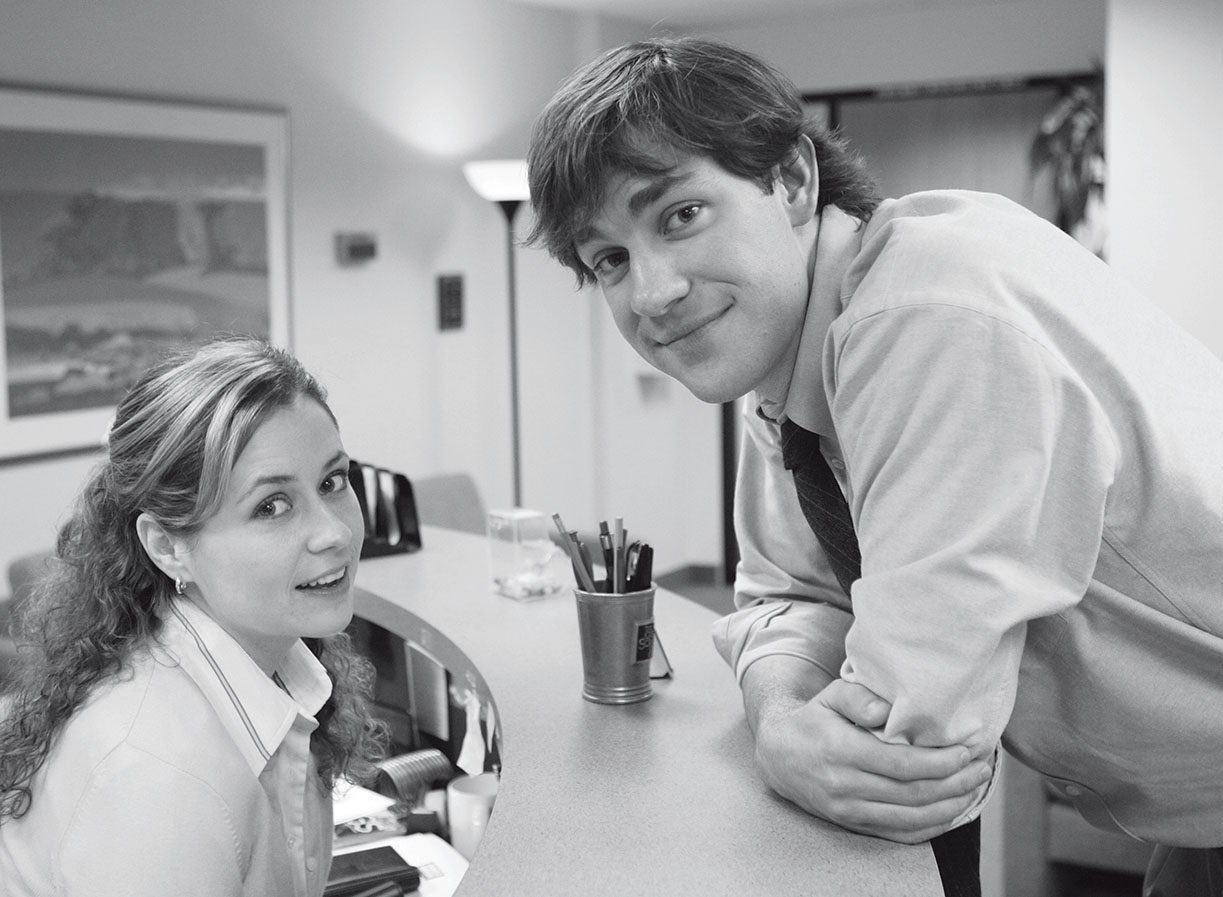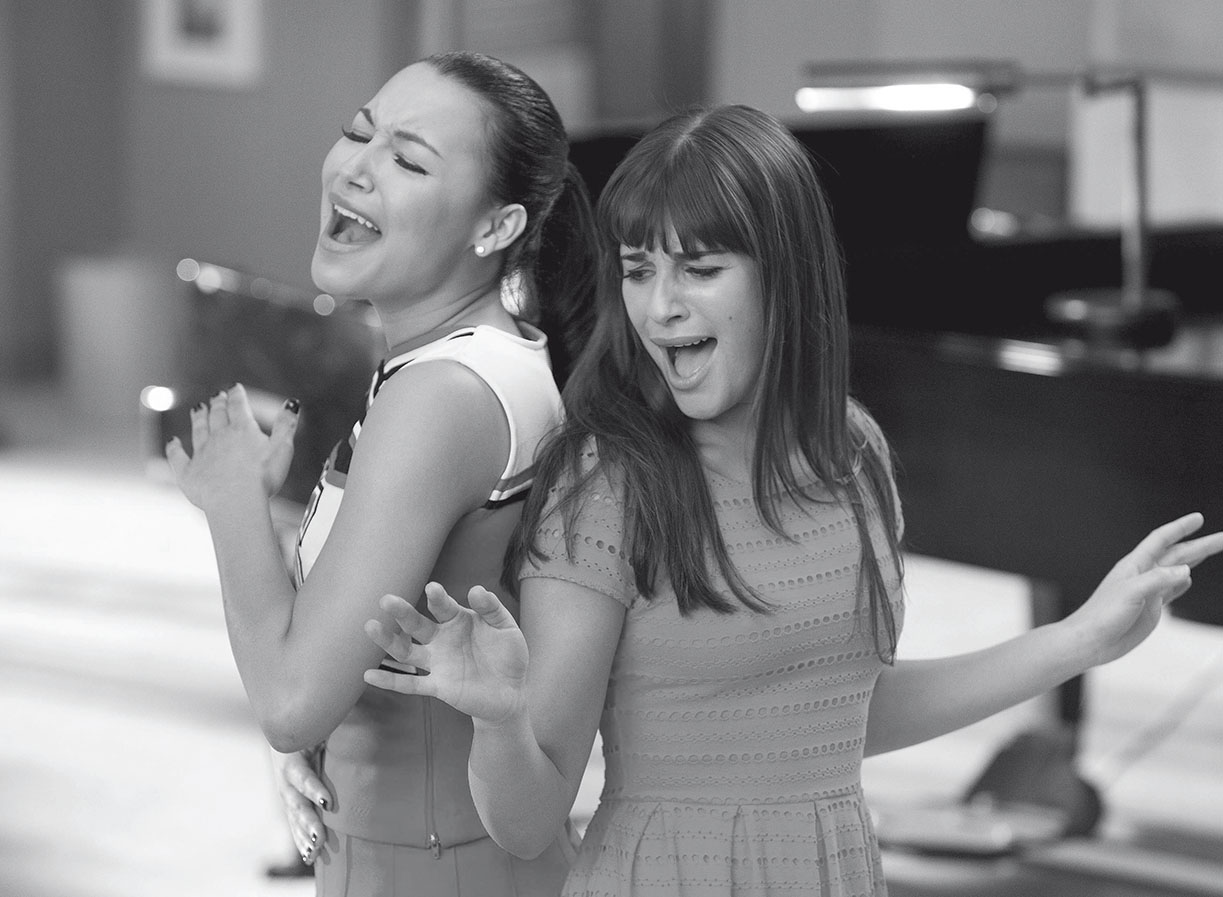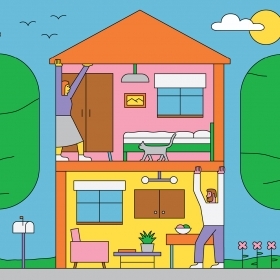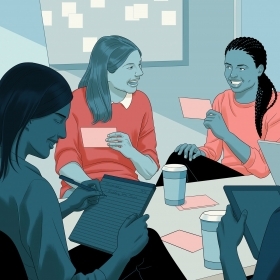“Watching TV really does help,” my 15-year-old daughter, Ruby, said recently after binge-watching The Office. She’s seen all nine seasons of the U.S. version of the British comedy series many times before. Still, she’s completely absorbed by the fictional goings-on at the show’s Dunder Mifflin Paper Company, and often laughs aloud at their silly office exploits.
“That’s good! Watch as much as you want. Whatever helps,” I tell her.
It may seem like strange parenting advice, and normally, it might be. But given we’ve mostly been stuck at home in Portland, Ore., socially isolating since last March, any distraction from our current predicament is welcome. Like so many other teenagers, Ruby and her older sister, Jess, 18, have been unable to attend school in person since the pandemic began, and they both crave structure, and connection. Watching TV has helped us cope with boredom, anxiety, and stress during this unusual time—in a very familiar way.
Revisiting old shows and knowing exactly what to expect is reassuring when the future seems especially uncertain. In most old sitcoms, you can count on any “issues” raised during the episode to resolve with a happy ending—and some laugh tracks along the way. Without our usual busy schedule and sense of order, watching TV provides a sense of regularity and structure. We don’t know what’s going to happen in the near future, but we know that Pam and Jim are going to get married on The Office. The connection isn’t lost on Ruby.
“I re-watch a lot of my favorite shows such as The Office, Glee, Gilmore Girls, Gossip Girl, and Parks and Rec for comfort,” she explains. “I feel like since I know what’s going to happen, there’s a sense of security.”

Coworkers-turned-couple Pam and Jim on The Office.
Photo by Chris Haston/NBCU Photobank

The opening credits of The Brady Bunch.

High schoolers Santana and Rachel perform in the musical comedy Glee.
Fox Image Collection via Getty Images

A new website is unveiled for the town of Pawnee, Ind., in an episode of Parks and Recreation.
Photo by Jordin Althaus/NBCU Photobank/NBC Universal via Getty Images
We’re certainly not the only ones finding solace in nostalgia lately. A recent New York Times article highlighted the emotional benefits of nostalgia. Experts say that getting absorbed in the plot of an old TV show or movie can provide psychological benefits that may last anywhere from a few minutes to a day. “It changes the narrative you’re constantly telling yourself,” Lasana Harris, an assistant professor of psychology at University College London, told the Times.
Indulging in nostalgia by watching old movies and TV shows has been shown to help cope with stress and anxiety. “We feel that we have lost footing at the present time, and we gain some comfort by taking a step back and revisiting something that reminds us of a time that we used to feel more connected with other people,” Wing Yee Cheung, an associate professor in psychology at the University of Winchester in England who studies nostalgia, told the New York Times. “It gives you energy to cope with what is going on now and move forward.”
Watching old TV series provides a double sense of nostalgia—there’s nostalgia for the show itself, but also for the time when you first experienced it. TV has marked every stage of my life with memories of the shows themselves, as well as the people I watched them with. As first-year students at Wellesley, every Tuesday night we’d cram into the one room on our floor in the basement of Davis that had a TV to tune into the latest episode of the hot new series Moonlighting. In the days before smartphones, laptops, and iPads, TV watching was something you did collectively—and at a scheduled time.
I haven’t been able to see my mother for a year, but while watching The Golden Girls, I return to my own teenage years, when we watched it together. The hit series about four women “of a certain age” living together in Miami premiered in 1985, the fall of my senior year of high school. Back then, the show’s stars (Bea Arthur, Betty White, Rue McClanahan, and Estelle Getty) seemed impossibly old. (The actresses were all in their early 60s, except for McClanahan, who was 51 when the show premiered.) Now that I’m solidly middle aged, they no longer seem so old. In fact, some of the topics they addressed—including menopause and age discrimination—that were once lost on me suddenly seem very relevant.
The Golden Girls and other old favorites transport me back to a time before COVID, but also before the internet and the myriad technological advances that have enriched but also complicated our lives. Suddenly, I’m back in my split-level suburban childhood home, complete with shag carpeting, macramé plant hangers, and a push-button wall phone. I have no idea that one day I will revisit the show in a very different context.
In most old sitcoms, you can count on any ‘issues’ raised during the episode to resolve with a happy ending—and some laugh tracks along the way. Without our usual busy schedule and sense of order, watching TV provides a sense of regularity and structure.
Though it’s tempting to view the past as a “simpler time,” watching the show now reminds me that some things have changed for the better—especially in terms of representation of women and people of color on TV. The other night, I asked Ruby to indulge me and join me for an episode of The Golden Girls. Snuggled together in the afghan blanket my mom knit for me before I headed off to Wellesley, Ruby and I watched “the girls” navigate the issue of in vitro fertilization. Back then, it was a contemporary topic—the first IVF baby was born in the United States in 1981. Now their attitudes seem incredibly dated. “Eww!” is the gist of their collective reaction.
Though The Golden Girls was considered forward-thinking in some ways—for instance, it addressed gay marriage long before it was accepted in prime time—it was retrograde in many others.
In the episode I watched with Ruby, there’s a joke about rape. Other episodes rely on racist humor and stereotypes about just about every racial and ethnic group. In one episode, Rue McClanahan’s Blanche romanticizes the “good old days” in the South when “Southerners could be Southerners” and she could fly her Confederate flag proudly.
Ruby has informed me she has no plans to watch more episodes of The Golden Girls since, as she pointed out, it’s “double-dated.” The show aired during the late 1980s and early 1990s, but the “old ladies” often reminisce about their lives, including their childhoods during the first part of the 20th century! Still, it’s important that she’s exposed to TV history, especially because it’s also part of our family heritage and links us to the past.
My husband, a filmmaker and video editor, has edited TV series and commercials throughout his career. His late father was part of the Emmy Award-winning writing team behind The Phil Silvers Show in 1955. I’m an entertainment journalist who worked as a TV reporter for years. I recently wrote a book Love Is All Around And Other Lessons We’ve Learned from The Mary Tyler Moore Show, and I’m currently writing a book about Betty White. You could say TV is the family business.
From the time the girls were in preschool, my husband and I made it a point to educate them about classic TV. When they were younger and streaming services didn’t yet exist, we would send away for Netflix DVDs of some of our favorite childhood shows. I got a kick out of exposing the girls to The Brady Bunch, which I have fond memories of watching every day during lunch after returning home from kindergarten. Even though we grew up decades apart, my daughters and I can bond over our shared Brady Bunch memories.
At the moment, it’s particularly hard to envision the future, but I find solace in the notion that perhaps one day, Ruby and Jess will watch The Office or another beloved show from their childhood with their children or friends. It’s hard to imagine it, but maybe they’ll even feel a pang of nostalgia about the time when they were stuck home watching TV with their parents.
Paula Bernstein ’90 is the author of Love Is All Around And Other Lessons We’ve Learned from The Mary Tyler Moore Show. She lives with her family in Portland, Ore.












We ask that those who engage in Wellesley magazine's online community act with honesty, integrity, and respect. (Remember the honor code, alums?) We reserve the right to remove comments by impersonators or comments that are not civil and relevant to the subject at hand. By posting here, you are permitting Wellesley magazine to edit and republish your comment in all media. Please remember that all posts are public.